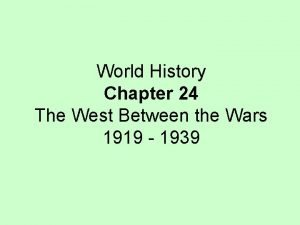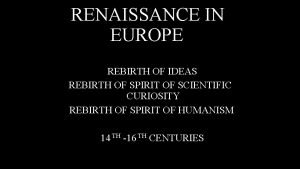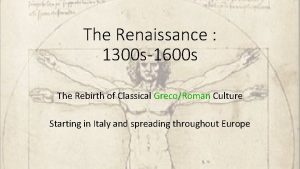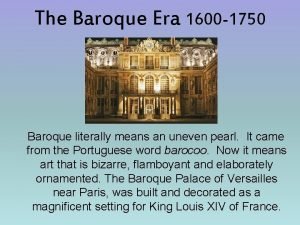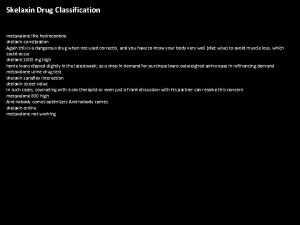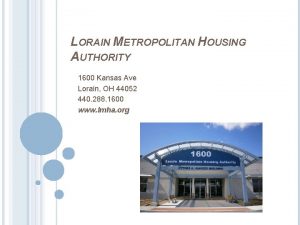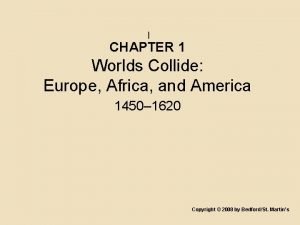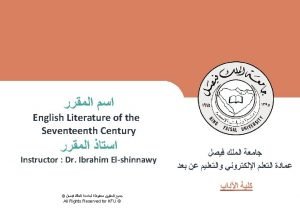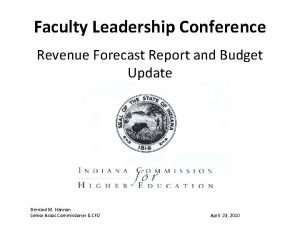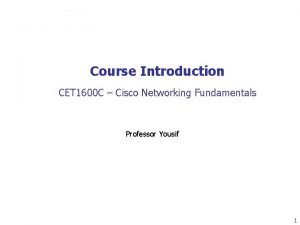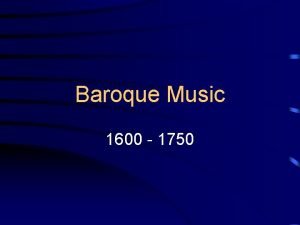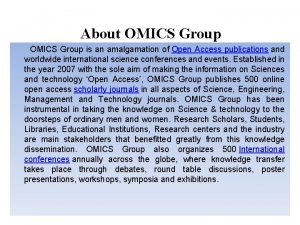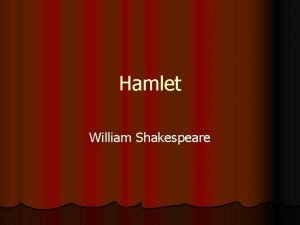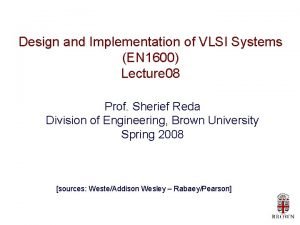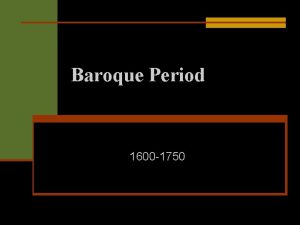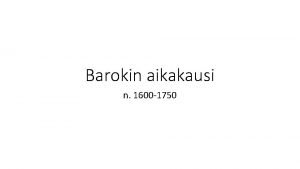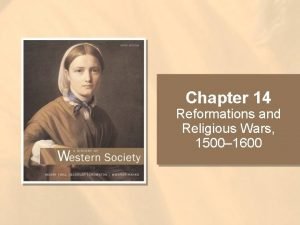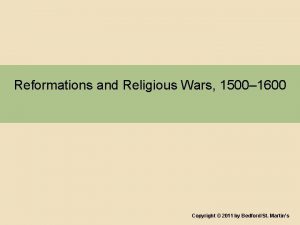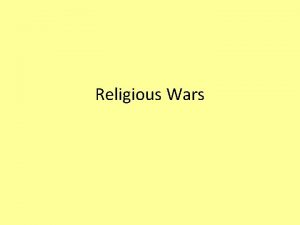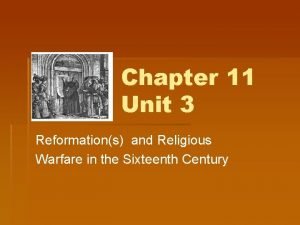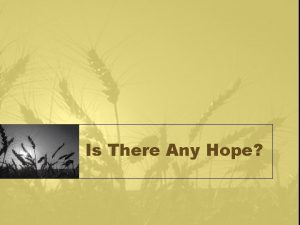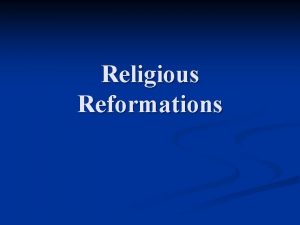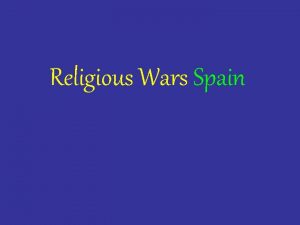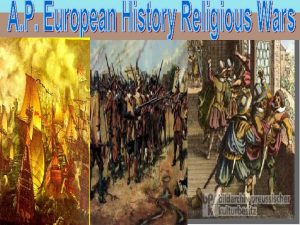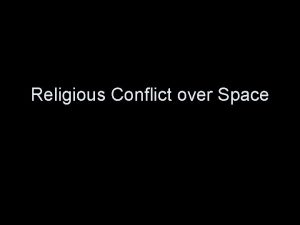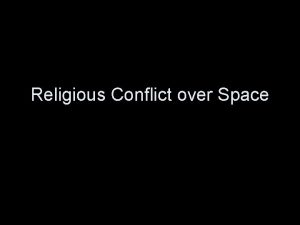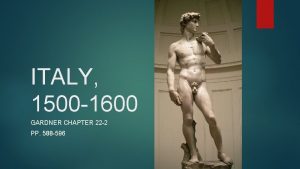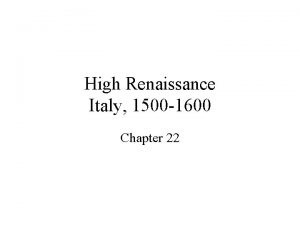Chapter 14 Reformations and Religious Wars 1500 1600





















- Slides: 21

Chapter 14 Reformations and Religious Wars, 1500– 1600

Question French Calvinists were called a) Anabaptists. b) Huguenots. c) Puritans. d) politiques. Copyright © Houghton Mifflin Company. All rights reserved. 14 | 2

Answer French Calvinists were called a) Anabaptists. b) Huguenots. (correct) c) Puritans. d) politiques. Hint: See page 473. Copyright © Houghton Mifflin Company. All rights reserved. 14 | 3

Question Which of the following cities was known as “a city that was a Church, ” and became the model of a Christian community for sixteenth-century Protestant reformers? a) Paris b) Geneva c) Zurich d) Cologne Copyright © Houghton Mifflin Company. All rights reserved. 14 | 4

Answer Which of the following cities was known as “a city that was a Church, ” and became the model of a Christian community for sixteenth-century Protestant reformers? a) Paris b) Geneva (correct) c) Zurich d) Cologne Hint: See page 463. Copyright © Houghton Mifflin Company. All rights reserved. 14 | 5

Question The first area outside of the Roman Empire to officially adopt the Protestant Reformation was the kingdom of a) Sweden. b) Denmark-Norway. c) Iceland. d) Scandinavia. Copyright © Houghton Mifflin Company. All rights reserved. 14 | 6

Answer The first area outside of the Roman Empire to officially adopt the Protestant Reformation was the kingdom of a) Sweden. b) Denmark-Norway. (correct) c) Iceland. d) Scandinavia. Hint: See page 451. Copyright © Houghton Mifflin Company. All rights reserved. 14 | 7

Question The new order of nuns, approved officially in 1565, that stressed education of girls and young women, was called the a) Jesuits. b) Jesuines. c) Society of Jesus. d) Ursulines. Copyright © Houghton Mifflin Company. All rights reserved. 14 | 8

Answer The new order of nuns, approved officially in 1565, that stressed education of girls and young women, was called the a) Jesuits. b) Jesuines. c) Society of Jesus. d) Ursulines. (correct) Hint: See page 469. Copyright © Houghton Mifflin Company. All rights reserved. 14 | 9

Question What was the name given to the statement of faith developed by the Lutherans at the Imperial Diet in 1530? a) Augsburg Confession b) Lutheran Creed c) Torgau Articles d) Golden Bull Copyright © Houghton Mifflin Company. All rights reserved. 14 | 10

Answer What was the name given to the statement of faith developed by the Lutherans at the Imperial Diet in 1530? a) Augsburg Confession (correct) b) Lutheran Creed c) Torgau Articles d) Golden Bull Hint: See page 458. Copyright © Houghton Mifflin Company. All rights reserved. 14 | 11

Question During the sixteenth and seventeenth centuries, somewhere between ____ and ____ people were executed for witchcraft. a) 40, 000; 60, 000 b) 100, 000; 200, 000 c) 50, 000; 75, 000 d) 120, 000; 140, 000 Copyright © Houghton Mifflin Company. All rights reserved. 14 | 12

Answer During the sixteenth and seventeenth centuries, somewhere between ____ and ____ people were executed for witchcraft. a) 40, 000; 60, 000 (correct) b) 100, 000; 200, 000 c) 50, 000; 75, 000 d) 120, 000; 140, 000 Hint: See pages 475– 476. Copyright © Houghton Mifflin Company. All rights reserved. 14 | 13

Question John Knox and the Reformation movement in Scotland were most influenced by a) Catholicism. b) Calvinism. c) Lutheranism. d) the Church of England. Copyright © Houghton Mifflin Company. All rights reserved. 14 | 14

Answer John Knox and the Reformation movement in Scotland were most influenced by a) Catholicism. b) Calvinism. (correct) c) Lutheranism. d) the Church of England. Hint: See page 465. Copyright © Houghton Mifflin Company. All rights reserved. 14 | 15

Question All of the following groups can trace their origins to the radicals of the sixteenth century EXCEPT the a) Puritans. b) Baptists. c) Congregationalists. d) Quakers. Copyright © Houghton Mifflin Company. All rights reserved. 14 | 16

Answer All of the following groups can trace their origins to the radicals of the sixteenth century EXCEPT the a) Puritans. (correct) b) Baptists. c) Congregationalists. d) Quakers. Hint: See page 454. Copyright © Houghton Mifflin Company. All rights reserved. 14 | 17

Question Within the Papal States, the Roman Inquisition effectively destroyed a) secret marriages. b) heresy. c) transubstantiation. d) radicals. Copyright © Houghton Mifflin Company. All rights reserved. 14 | 18

Answer Within the Papal States, the Roman Inquisition effectively destroyed a) secret marriages. b) heresy. (correct) c) transubstantiation. d) radicals. Hint: See page 467. Copyright © Houghton Mifflin Company. All rights reserved. 14 | 19

Question Charles V was a vigorous defender of a) Martin Luther. b) Protestantism. c) Catholicism. d) Calvinism. Copyright © Houghton Mifflin Company. All rights reserved. 14 | 20

Answer Charles V was a vigorous defender of a) Martin Luther. b) Protestantism. c) Catholicism. (correct) d) Calvinism. Hint: See page 458. Copyright © Houghton Mifflin Company. All rights reserved. 14 | 21
 Chapter 24 the west between the wars
Chapter 24 the west between the wars Venetia 1600 births and rebirths
Venetia 1600 births and rebirths Venetia 1600 births and rebirths
Venetia 1600 births and rebirths America africa and europe before 1500
America africa and europe before 1500 1600+1750
1600+1750 Orbitronics batteries
Orbitronics batteries 1600 mg skelaxin
1600 mg skelaxin Emap
Emap Lmha lorain
Lmha lorain 1600 lexile
1600 lexile Abcdarab
Abcdarab Foam pro 1600
Foam pro 1600 The puritan age (1600 to 1660)
The puritan age (1600 to 1660) 1600-1329
1600-1329 Cet 1600
Cet 1600 Dynamics in baroque music
Dynamics in baroque music 855-489-1600
855-489-1600 300000/1600
300000/1600 Wittenberg hamlet
Wittenberg hamlet En 1600
En 1600 Buxtehude composer
Buxtehude composer 1600-1750
1600-1750
